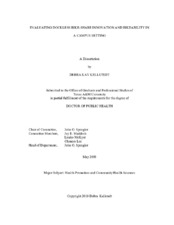| dc.description.abstract | Physical activity at colleges can be improved through bicycling. Cycling can be performed easily and develop into a life-long activity. College campuses have a unique opportunity to promote cycling behaviors for a large number of young adults. Bike-share environmental interventions can make biking more accessible in these settings. This dissertation has three aims: 1. Examine usage and factors predicting bike-share adoption and explore themes related to bike-share use on campus after an innovative dockless bike-share system launch through a multimethod approach using surveys and focus groups. The Diffusion of Innovations Theory guided the analysis. 2. Conduct a scoping review to summarize recent studies that describe a tool or method for measuring bikeability. The review searched both EBSCO and transportation databases, described the tools, and provided an analysis of tool characteristics using practical comparisons. 3. Using student participation, assess both objective measures and perceptions of bikeability in terms of safety, quality, and comfort. The multi-method approach included bike-share user focus groups and mapping activities along with a direct observation audit. For the first aim, survey data from 2,845 students, faculty, and staff revealed that 33.6% had used bike-share. Bike users were more likely to be students, freshmen, living on campus, current bikers, and have confidence in their biking ability. Focus groups revealed that safety was a concern, knowledge about how the program worked was low among non-users, cost was a barrier, and bike parking needed improvement. For the second aim, eighteen recent studies were identified that used ten unique bikeability tools. All but one tool assessed environmental features at the microscale level. The variety of tools were applied in a broad range of settings, from large cities to college campuses, among cycle commuters and those with biking experience. The tools included a wide variety of variables, and it is unclear which accurately predict bikeability. For aim three, student perceptions of bikeability on five commonly-used routes did not match the objective assessments of those routes. Perceptions of campus bikeability (for safety, quality, and comfort), as reflected in the focus groups, were poorer than the ratings scored in the environmental audits. | en |


